Corrosion Fatigue Test and Performance Evaluation of High-Strength Steel Wires Based on the Suspender of a 11-Year-Old Concrete-Filled Steel Tube Arch Bridge
Abstract
:1. Introduction
2. Materials and Experimental Preparation
2.1. Engineering Background
2.2. Salt Spray Corrosion Test and Specimen Production
2.3. Corrosion Specimen Phenomenon and Treatment
2.4. Surface Profile Measurement
3. Results and Discussion of the Fatigue Performance of Corroded Steel Wire
3.1. Test Equipment and Scheme
3.2. Loading Conditions and Fatigue Life Test Results
3.3. Fatigue Port Morphology Analysis
3.4. Corrosion Effects on Fatigue Life of Steel Wire
4. Conclusions
- Corrosion has a significant effect on the surface morphology of steel wire. As the corrosion degree increased, the roughness Ra of the steel wire showed an increasing trend, and the corrosion degree increased. The corrosion pits close to each other become larger, resulting in an increase in the width of the connected corrosion pits.
- Environmental erosion forms microscopic cracks on the surface of the steel wire, owing to the environmental erosion that leads to crack propagation, thus resulting in practical failure under the action of stress. The fatigue life of the corroded steel wire which was polished and cleaned using mechanical grinding improved by about 30% in a stress range of 360 MPa.
- According to the measured data, the stress-life-corrosion scatter diagram exhibits a two-stage shape. When ΔS > 360 MPa, the fatigue life of steel wire increases at a similar rate with stress reduction. When ΔS ≤ 360 MPa, the fatigue life of steel wire increases more consumingly with the decrease of stress. With the decrease of stress, corrosion has more and more a significant effect on the life of corroded steel wire.
- The fatigue data under different corrosion degrees and stress amplitudes were summarized using the statistical method. The cumulative function of the fatigue life probability of high-strength steel wires of bridge hanger rods with two stages was established, and the stress-life-corrosion rate surface equation of steel wires with different survival rates was provided, which can be selected according to different design requirements.
Author Contributions
Funding
Institutional Review Board Statement
Informed Consent Statement
Data Availability Statement
Conflicts of Interest
Appendix A
| No. | Accelerated Corrosion Time (Day) | η (%) | ΔS (MPa) | Number of Cycles (×106) | No. | Accelerated Corrosion Time (Day) | η (%) | ΔS (MPa) | Number of Cycles (×106) |
|---|---|---|---|---|---|---|---|---|---|
| 1 | 10 | 2.34 | 270 | 2.4071 | 62 | 40 | 7.96 | 630 | 0.1252 |
| 2 | 10 | 2.45 | 270 | 2.1812 | 63 | 40 | 8.68 | 630 | 0.0933 |
| 3 | 10 | 2.56 | 270 | 2.2402 | 64 | 60 | 9.98 | 270 | 1.427 |
| 4 | 10 | 2.18 | 360 | 0.9220 | 65 | 60 | 9.36 | 270 | 1.5272 |
| 5 | 10 | 2.38 | 360 | 0.8943 | 66 | 60 | 9.69 | 270 | 1.4628 |
| 6 | 10 | 2.92 | 360 | 0.7805 | 67 | 60 | 10.19 | 360 | 0.5894 |
| 7 | 10 | 2.67 | 450 | 0.5892 | 68 | 60 | 9.98 | 360 | 0.4854 |
| 8 | 10 | 2.45 | 450 | 0.6195 | 69 | 60 | 9.65 | 360 | 0.5200 |
| 9 | 10 | 2.57 | 450 | 0.6054 | 70 | 60 | 9.80 | 450 | 0.3545 |
| 10 | 10 | 2.32 | 450 | 0.659 | 71 | 60 | 10.08 | 450 | 0.4587 |
| 11 | 10 | 2.83 | 450 | 0.4493 | 72 | 60 | 9.69 | 450 | 0.424 |
| 12 | 10 | 2.66 | 540 | 0.3407 | 73 | 60 | 10.31 | 450 | 0.4597 |
| 13 | 10 | 2.64 | 540 | 0.3384 | 74 | 60 | 9.80 | 450 | 0.4294 |
| 14 | 10 | 2.35 | 540 | 0.3538 | 75 | 60 | 10.57 | 540 | 0.1206 |
| 15 | 10 | 2.56 | 540 | 0.3305 | 76 | 60 | 9.66 | 540 | 0.1481 |
| 16 | 10 | 2.40 | 540 | 0.2974 | 77 | 60 | 10.06 | 540 | 0.1331 |
| 17 | 10 | 2.45 | 630 | 0.2550 | 78 | 60 | 9.52 | 540 | 0.1113 |
| 18 | 10 | 2.40 | 630 | 0.2126 | 79 | 60 | 9.77 | 540 | 0.1633 |
| 19 | 10 | 2.32 | 630 | 0.2638 | 80 | 60 | 9.81 | 630 | 0.0807 |
| 20 | 10 | 2.34 | 630 | 0.20524 | 81 | 60 | 10.13 | 630 | 0.0937 |
| 21 | 10 | 2.46 | 630 | 0.1736 | 82 | 60 | 10.30 | 630 | 0.0969 |
| 22 | 20 | 5.36 | 270 | 1.8841 | 83 | 60 | 10.10 | 630 | 0.0959 |
| 23 | 20 | 5.41 | 270 | 1.9496 | 84 | 60 | 9.88 | 630 | 0.1096 |
| 24 | 20 | 4.97 | 270 | 1.8612 | 85 | 90 | 11.63 | 270 | 1.3749 |
| 25 | 20 | 5.07 | 360 | 0.8185 | 86 | 90 | 11.19 | 270 | 1.3276 |
| 26 | 20 | 5.20 | 360 | 0.829 | 87 | 90 | 11.74 | 270 | 1.2995 |
| 27 | 20 | 5.32 | 360 | 0.7679 | 88 | 90 | 11.29 | 360 | 0.4714 |
| 28 | 20 | 5.55 | 450 | 0.5541 | 89 | 90 | 11.31 | 360 | 0.4235 |
| 29 | 20 | 5.24 | 450 | 0.4942 | 90 | 90 | 11.56 | 360 | 0.5005 |
| 30 | 20 | 5.58 | 450 | 0.4832 | 91 | 90 | 11.40 | 450 | 0.2316 |
| 31 | 20 | 5.41 | 450 | 0.4967 | 92 | 90 | 11.46 | 450 | 0.3652 |
| 32 | 20 | 5.56 | 450 | 0.5817 | 93 | 90 | 11.69 | 450 | 0.3428 |
| 33 | 20 | 5.33 | 540 | 0.2636 | 94 | 90 | 11.83 | 450 | 0.3049 |
| 34 | 20 | 5.15 | 540 | 0.2214 | 95 | 90 | 11.44 | 450 | 0.3629 |
| 35 | 20 | 4.97 | 540 | 0.1985 | 96 | 90 | 11.60 | 540 | 0.1040 |
| 36 | 20 | 5.33 | 540 | 0.2166 | 97 | 90 | 11.42 | 540 | 0.0746 |
| 37 | 20 | 5.48 | 540 | 0.1966 | 98 | 90 | 11.57 | 540 | 0.0947 |
| 38 | 20 | 5.23 | 630 | 0.1177 | 99 | 90 | 11.64 | 540 | 0.1082 |
| 39 | 20 | 5.18 | 630 | 0.1567 | 100 | 90 | 11.30 | 540 | 0.0921 |
| 40 | 20 | 5.23 | 630 | 0.1231 | 101 | 90 | 11.59 | 630 | 0.0675 |
| 41 | 20 | 5.05 | 630 | 0.1639 | 102 | 90 | 11.69 | 630 | 0.0663 |
| 42 | 20 | 5.19 | 630 | 0.1213 | 103 | 90 | 11.53 | 630 | 0.0756 |
| 43 | 40 | 8.23 | 270 | 1.6914 | 104 | 90 | 12.05 | 630 | 0.067 |
| 44 | 40 | 8.77 | 270 | 1.737 | 105 | 90 | 11.31 | 630 | 0.0674 |
| 45 | 40 | 8.30 | 270 | 1.6680 | Fatigue data after polishing | ||||
| 46 | 40 | 8.77 | 360 | 0.6841 | 106 | 10 | 2.29 | 360 | 1.1875 |
| 47 | 40 | 7.97 | 360 | 0.7736 | 107 | 10 | 2.26 | 360 | 1.2471 |
| 48 | 40 | 8.37 | 360 | 0.6715 | 108 | 10 | 2.34 | 360 | 1.2865 |
| 49 | 40 | 8.12 | 450 | 0.4203 | 109 | 20 | 5.43 | 360 | 1.0064 |
| 50 | 40 | 8.39 | 450 | 0.4502 | 110 | 20 | 5.26 | 360 | 1.1348 |
| 51 | 40 | 8.39 | 450 | 0.4232 | 111 | 20 | 5.37 | 360 | 1.0956 |
| 52 | 40 | 7.51 | 450 | 0.4597 | 112 | 40 | 7.94 | 360 | 0.8887 |
| 53 | 40 | 7.78 | 450 | 0.4294 | 113 | 40 | 8.25 | 360 | 0.9773 |
| 54 | 40 | 7.74 | 540 | 0.1682 | 114 | 40 | 8.02 | 360 | 1.0266 |
| 55 | 40 | 8.33 | 540 | 0.2125 | 115 | 60 | 10.14 | 360 | 0.8010 |
| 56 | 40 | 8.66 | 540 | 0.1473 | 116 | 60 | 9.93 | 360 | 0.9290 |
| 57 | 40 | 8.10 | 540 | 0.1824 | 117 | 60 | 10.07 | 360 | 0.8136 |
| 58 | 40 | 8.46 | 540 | 0.1845 | 118 | 90 | 11.71 | 360 | 0.6832 |
| 59 | 40 | 8.37 | 630 | 0.1174 | 119 | 90 | 11.46 | 360 | 0.8350 |
| 60 | 40 | 7.87 | 630 | 0.0992 | 120 | 90 | 11.53 | 360 | 0.6984 |
| 61 | 40 | 8.33 | 630 | 0.0727 | |||||
References
- Xin, C.; Jinsong, Z.; Yangzi, L. Corrosion damage identification of suspenders of arch bridges in service based on guided wave multi-point scattering. J. Vibr. Shock 2021, 40, 295–301. [Google Scholar]
- Sun, Z.; Ning, S.; Shen, Y. Failure Investigation and Replacement Implementation of Short Suspenders in a Suspension Bridge. J. Bridge Eng. 2017, 22, 05017007. [Google Scholar] [CrossRef]
- Feng, D.; Mauch, C.; Summerville, S.; Fernandez, O. Suspender Replacement for a Signature Bridge. J. Bridge Eng. 2018, 23, 05018010. [Google Scholar] [CrossRef]
- Deng, Y.; Deng, L. Suspender Replacement Method for Long-Span Concrete-Filled Steel Tubular Arch Bridges and Cable Force Measurement Based on Frequency Method. Adv. Civil Eng. 2021, 2021, 7308816. [Google Scholar] [CrossRef]
- Sun, H.; Xu, J.; Chen, W.; Yang, J. Time-Dependent Effect of Corrosion on the Mechanical Characteristics of Stay Cable. J. Bridge Eng. 2018, 23, 04018019. [Google Scholar] [CrossRef]
- Li, H.; Lan, C.; Ju, Y.; Li, D.S. Experimental and Numerical Study of the Fatigue Properties of Corroded Parallel Wire Cables. J. Bridge Eng. 2012, 17, 211–220. [Google Scholar] [CrossRef]
- Lonetti, P.; Pascuzzo, A. Vulnerability and failure analysis of hybrid cable-stayed suspension bridges subjected to damage mechanisms. Eng. Fail. Anal. 2014, 45, 470–495. [Google Scholar] [CrossRef]
- Jarwali, T.; Nakamura, S. Anti-corrosion performance of bridge strands consisting of steel wires galvanised with zinc-aluminium alloy. Struct. Infrastruct. Eng. 2016, 12, 682–694. [Google Scholar] [CrossRef]
- Xue, S.; Shen, R. Corrosion-Fatigue Analysis of High-Strength Steel Wire by Experiment and the Numerical Simulation. Metals 2020, 10, 734. [Google Scholar] [CrossRef]
- Mayrbaurl, R.M.; Camo, S. Cracking and fracture of suspension bridge wire. J. Bridge Eng. 2001, 6, 645–650. [Google Scholar] [CrossRef]
- Betti, R.; West, A.C.; Vermaas, G.; Cao, Y. Corrosion and Embrittlement in High-Strength Wires of Suspension Bridge Cables. J. Bridge Eng. 2005, 10, 151–162. [Google Scholar] [CrossRef]
- Nakamura, S.; Suzumura, K. Experimental Study on Fatigue Strength of Corroded Bridge Wires. J. Bridge Eng. 2013, 18, 200–209. [Google Scholar] [CrossRef]
- Li, R.; Miao, C.; Feng, Z.; Wei, T. Experimental study on the fatigue behavior of corroded steel wire. J. Constr. Steel Res. 2021, 176, 106375. [Google Scholar] [CrossRef]
- Wang, Y.; Zhang, W.; Pan, X.; Zheng, Y. Experimental Study on Fatigue Crack Propagation of High-Strength Steel Wire with Initial Defects for Bridge Cables. Appl. Sci. 2020, 10, 4065. [Google Scholar] [CrossRef]
- Zheng, Y.; Wang, Y. Damage evolution simulation and life prediction of high-strength steel wire under the coupling of corrosion and fatigue. Corros. Sci. 2020, 164, 108368. [Google Scholar] [CrossRef]
- Ma, Y.; Wang, G.; Guo, Z.; Wang, L.; Jiang, T.; Zhang, J. Critical region method-based fatigue life prediction of notched steel wires of long-span bridges. Constr. Build. Mater. 2019, 225, 601–610. [Google Scholar] [CrossRef]
- Zheng, X.; Xie, X.; Li, X.; Qian, L.; Shen, Y. Estimation model for steel wire crack propagation and its application in calculation of pre-corrosion fatigue life. China Civil Eng. J. 2017, 3, 101–107. [Google Scholar]
- Zheng, X.; Xie, X.; Li, X. Experimental Study and Residual Performance Evaluation of Corroded High-Tensile Steel Wires. J. Bridge Eng. 2017, 22, 04017091. [Google Scholar] [CrossRef]
- Miao, C.; Yu, J.; Mei, M. Distribution law of corrosion pits on steel suspension wires for a tied arch bridge. Anti-Corros. Methods Mater 2016, 63, 166–170. [Google Scholar] [CrossRef]
- Zheng, X.; Xie, X.; Li, X. Experimental study on fatigue performance of corroded high tensile steel wires of arch bridge hangers. China Civil Eng. J. 2015, 48, 68–76. [Google Scholar]
- Lan, C.; Xu, Y.; Liu, C.; Li, H.; Spencer, B. Fatigue life prediction for parallel-wire stay cables considering corrosion effects. Int. J. Fatigue 2018, 114, 81–91. [Google Scholar] [CrossRef]
- Lan, C.M.; Xu, Y.; Ren, D.L.; Li, N.; Liu, Z. Fatigue property assessment of parallel wire stay cable I: Fatigue life model for wire. China Civil Eng. J. 2017, 6, 62–70. [Google Scholar]
- Lan, C.; Ren, D.; Xu, Y.; Li, N.; Liu, Z. Fatigue property assessment of parallel wire stay cable II: Fatigue life model for stay cable. China Civil Eng. J. 2017, 7, 69–77. [Google Scholar]
- Chen, A.; Yang, Y.; Ma, R.; Li, L.; Tian, H.; Pan, Z. Experimental study of corrosion effects on high-strength steel wires considering strain influence. Constr. Build. Mater. 2020, 240, 117910. [Google Scholar] [CrossRef]
- Jiang, C.; Wu, C.; Jiang, X. Experimental study on fatigue performance of corroded high-strength steel wires used in bridges. Constr. Build. Mater. 2018, 187, 681–690. [Google Scholar] [CrossRef]
- International Organization for Standardization. Corrosion Tests in Artificial Atmosphere Salt Spray Tests; HIS under license with ISO: Geneva, Switzerland, 1990; p. 9227. [Google Scholar]
- Suzumura, K.; Nakamura, S. Environmental factors affecting corrosion of galvanized steel wires. J. Mater. Civ. Eng. 2004, 16, 1–7. [Google Scholar] [CrossRef]
- Yuan, Y.; Liu, X.; Pu, G.; Wang, T.; Zheng, D. Temporal and spatial variability of corrosion of high-strength steel wires within a bridge stay cable. Constr. Build. Mater. 2021, 308, 125108. [Google Scholar] [CrossRef]
- International Organization for Standardization. Corrosion of Metals and Alloys-Removal of Corrosion Products from Corrosion Test Specimens; HIS under llicense with ISO: Geneva, Switzerland, 1991; p. 8407. [Google Scholar]
- GB/T 17101-2008; Hot-Dip Galvanized Steel Wires for Bridge Cables. B.C.S. Press: Swindon, UK, 2008.
- Lan, C.; Bai, N.; Yang, H.; Liu, C.; Li, H.; Spencer, B.F., Jr. Weibull modeling of the fatigue life for steel rebar considering corrosion effect. Int. J. Fatigue 2018, 111, 134–143. [Google Scholar] [CrossRef]
- Castillo, E.; López-Aenlle, M.; Ramos, A.; Fernández-Canteli, A.; Kieselbach, R.; Esslinger, V. Specimen length effect on parameter estimation in modelling fatigue strength by Weibull distribution. Int. J. Fatigue 2006, 28, 1047–1058. [Google Scholar] [CrossRef]
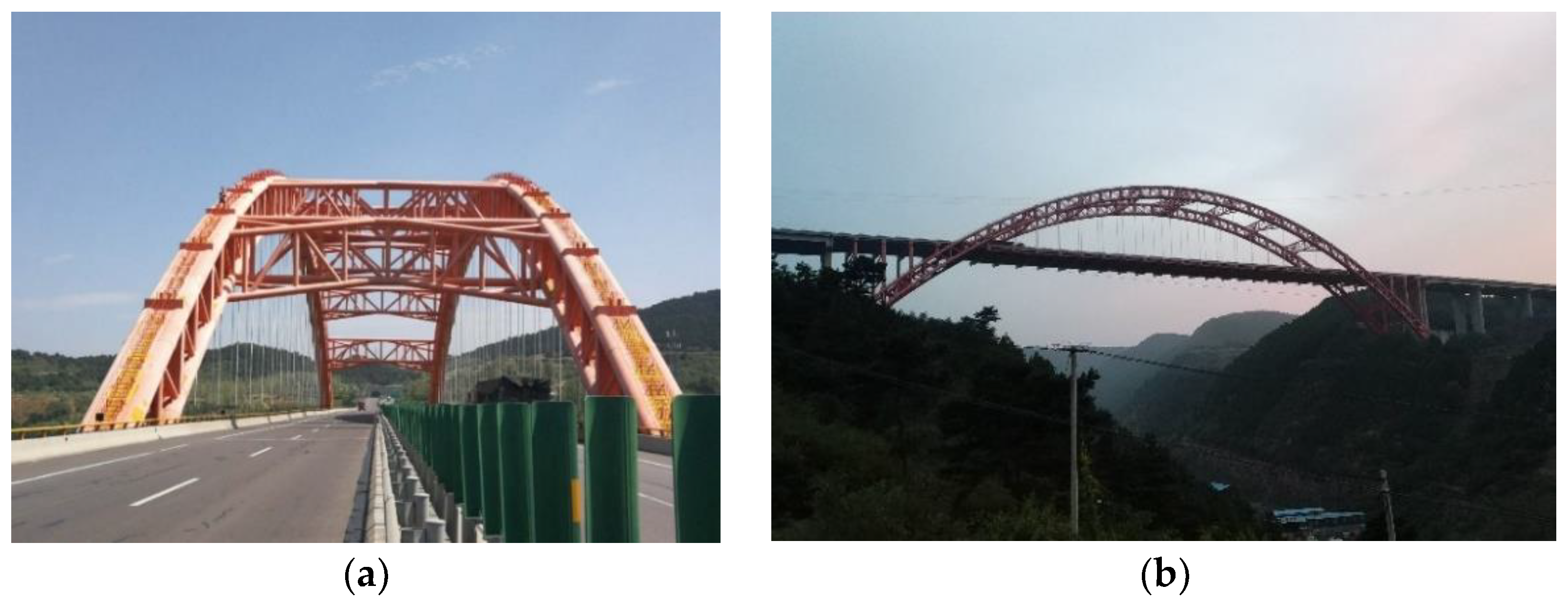





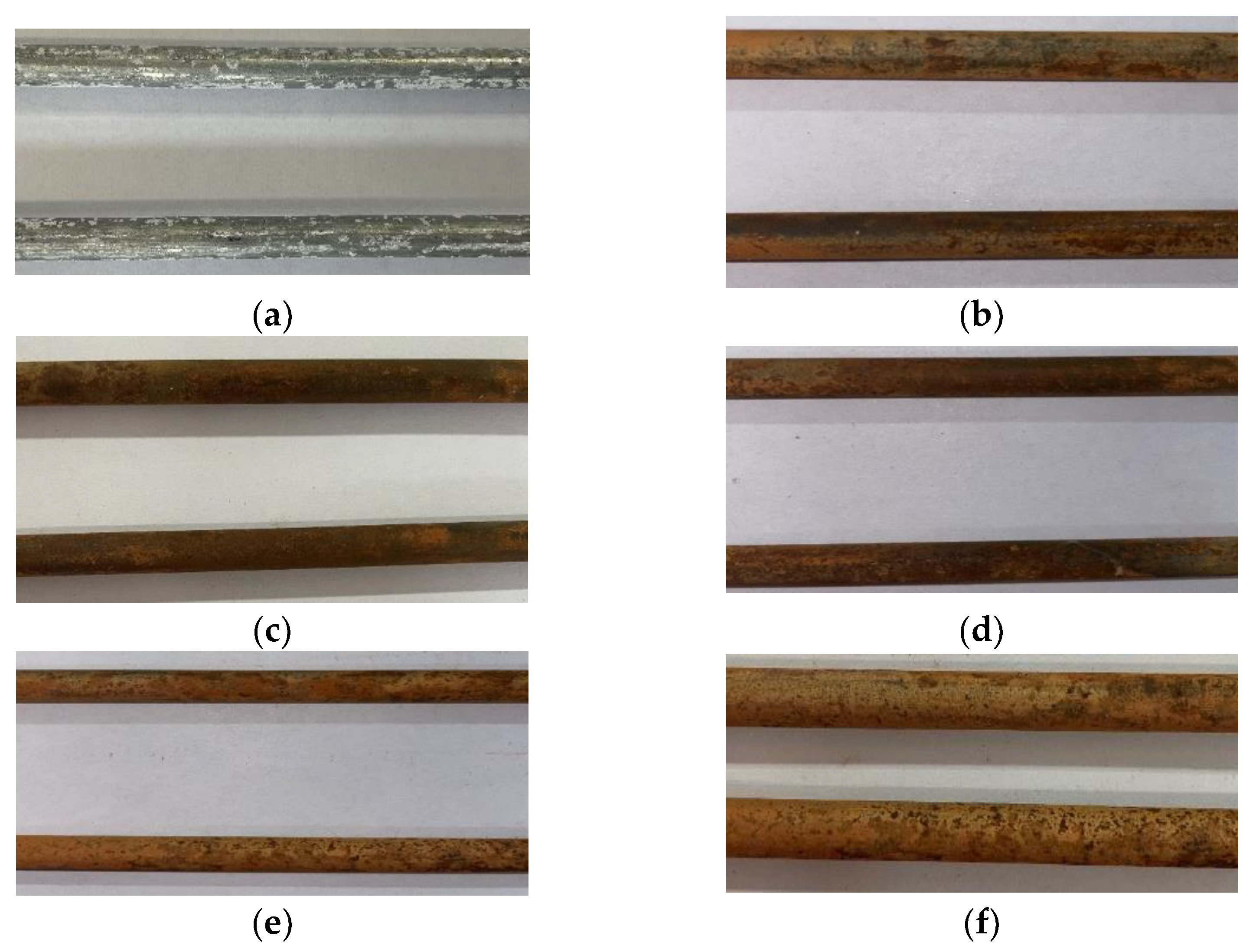



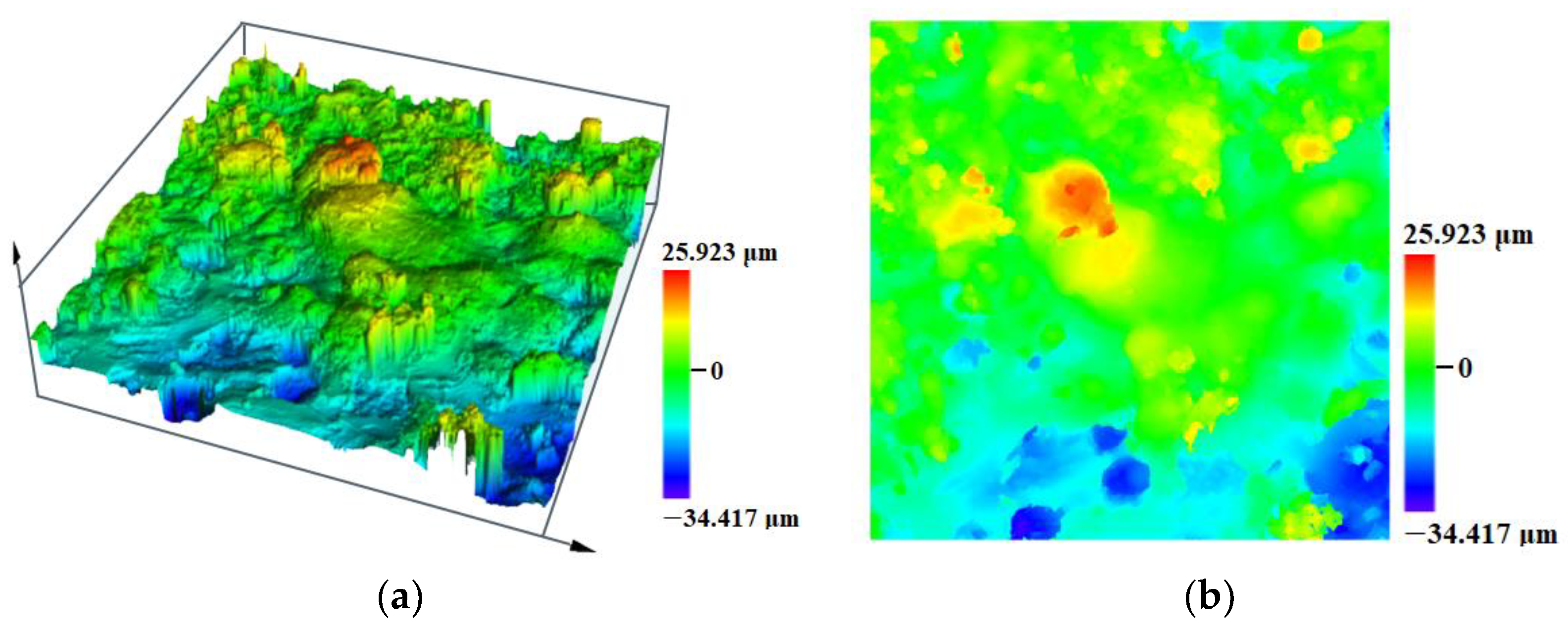
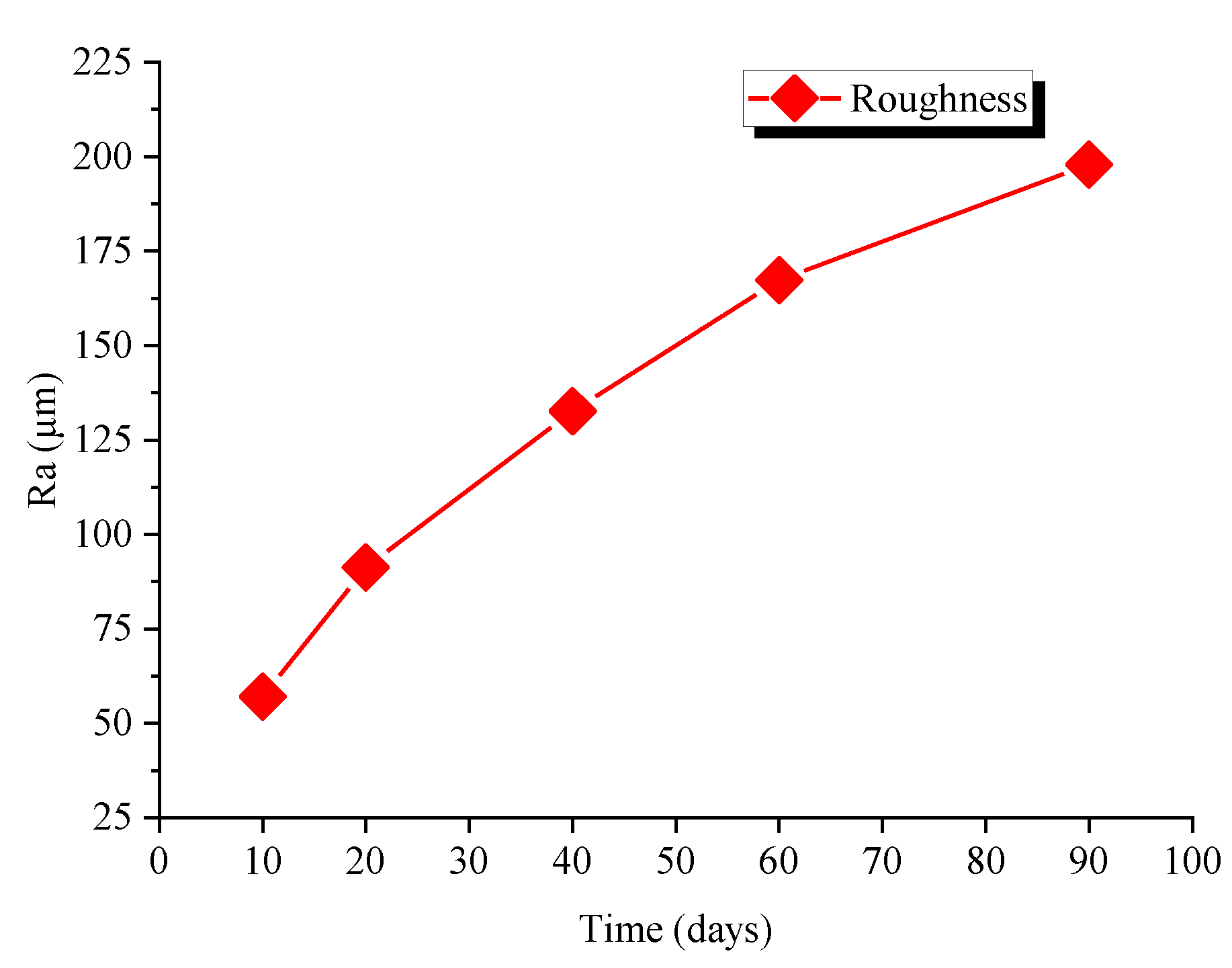
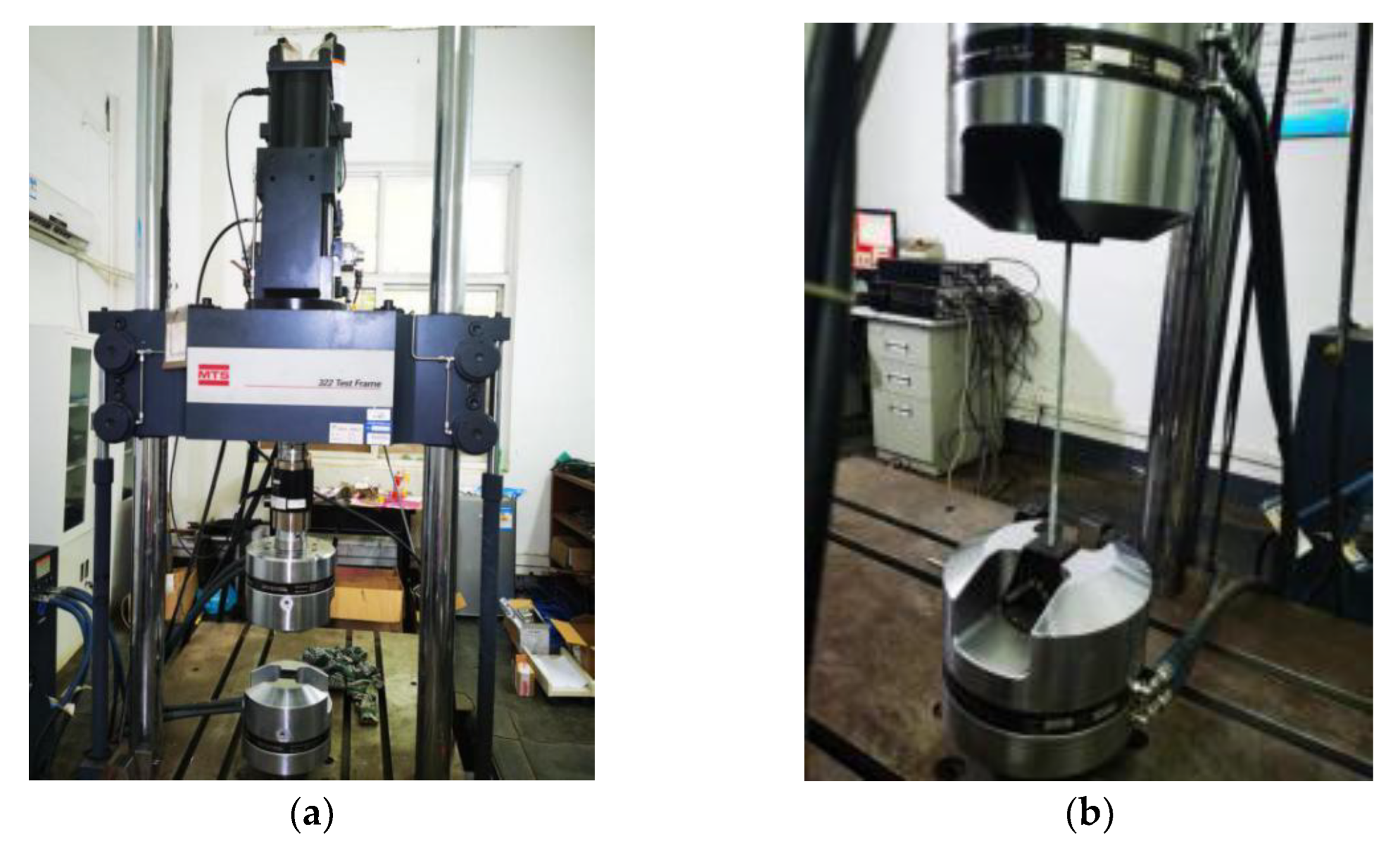

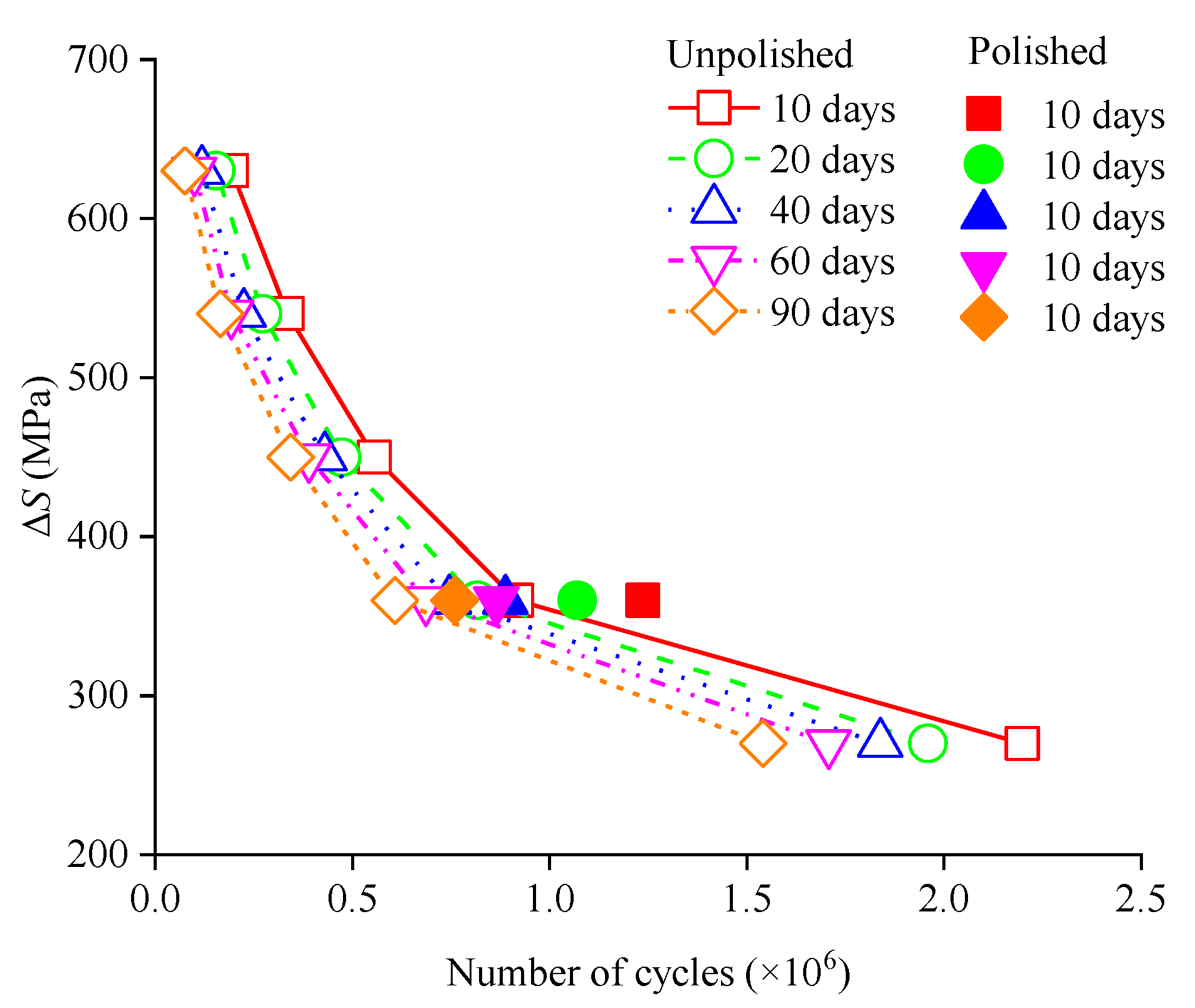
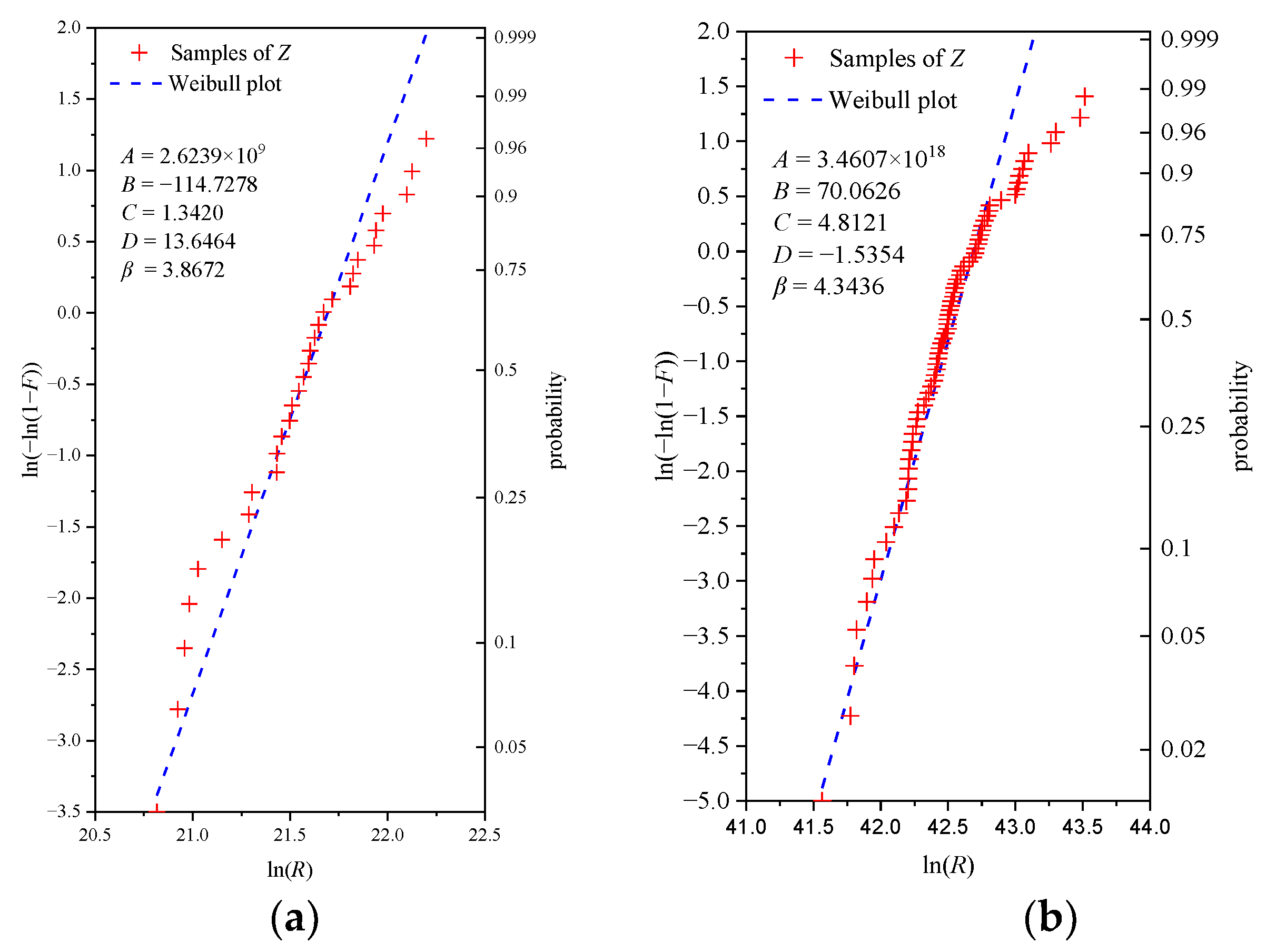
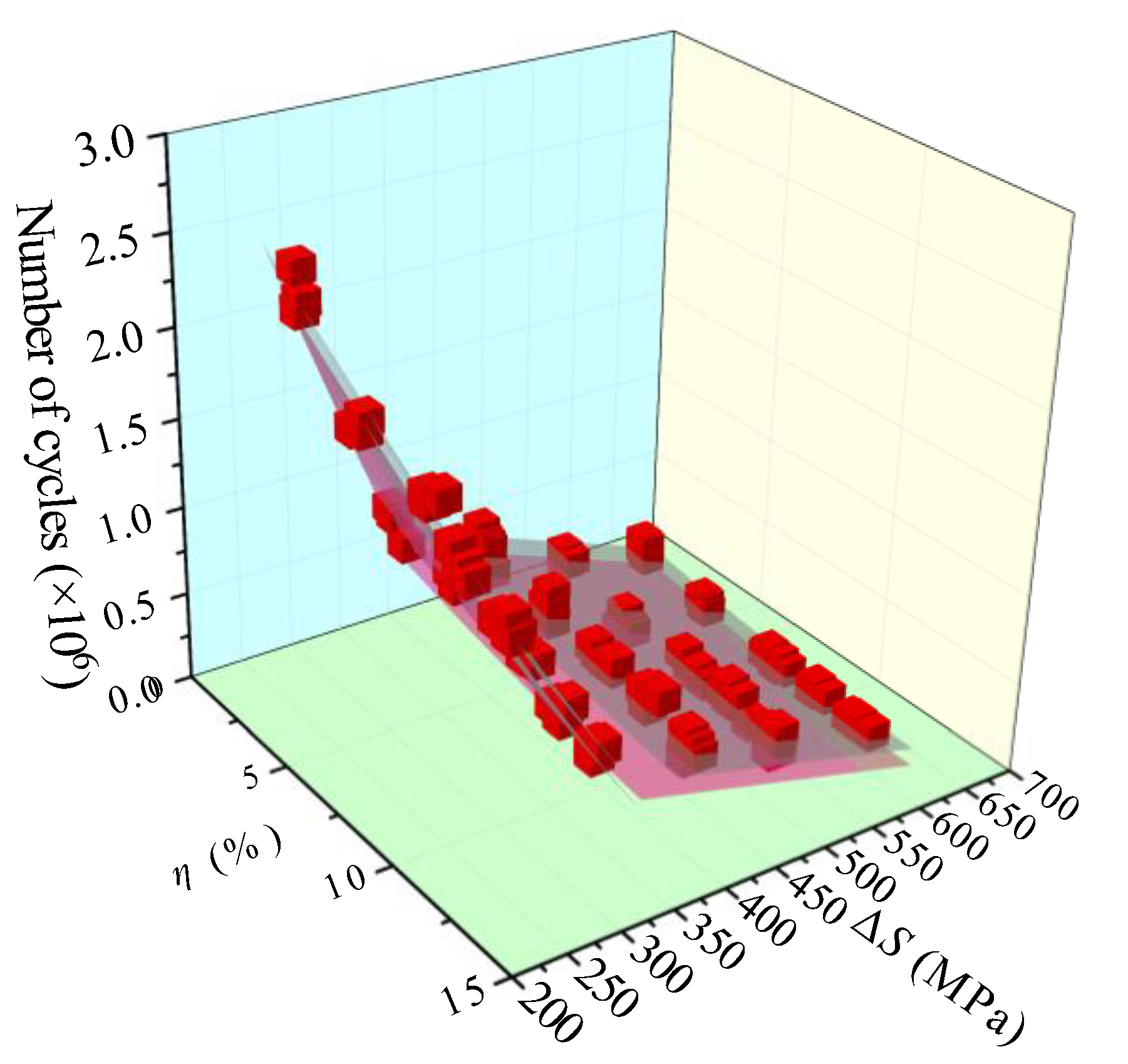
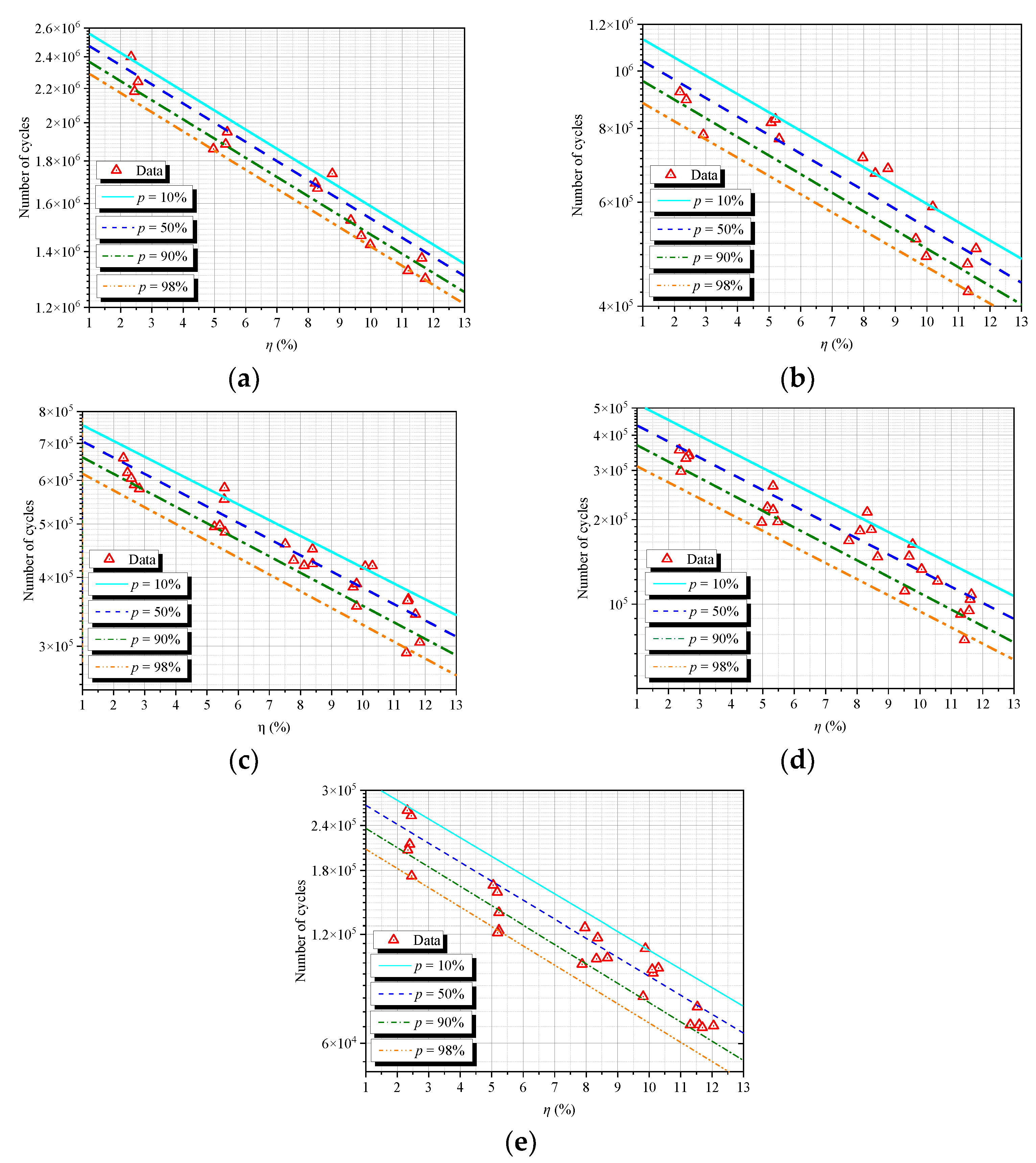
| Compositions | C | Si | Mn | S | Cu | Cr |
|---|---|---|---|---|---|---|
| wt.% | 0.85–0.90 | 0.12–0.32 | 0.60–0.90 | ≤0.0025 | ≤0.10 | 0.10–0.25 |
| Corrosion Time (d) | ΔS ≤ 360 MPa | R2 | ΔS > 360 MPa | R2 |
|---|---|---|---|---|
| 10 | 1 | 0.9949 | ||
| 20 | 1 | 0.9969 | ||
| 40 | 1 | 0.9981 | ||
| 60 | 1 | 0.9989 | ||
| 90 | 1 | 0.9949 |
Publisher’s Note: MDPI stays neutral with regard to jurisdictional claims in published maps and institutional affiliations. |
© 2022 by the authors. Licensee MDPI, Basel, Switzerland. This article is an open access article distributed under the terms and conditions of the Creative Commons Attribution (CC BY) license (https://creativecommons.org/licenses/by/4.0/).
Share and Cite
Deng, Y.; Deng, L. Corrosion Fatigue Test and Performance Evaluation of High-Strength Steel Wires Based on the Suspender of a 11-Year-Old Concrete-Filled Steel Tube Arch Bridge. Coatings 2022, 12, 1475. https://doi.org/10.3390/coatings12101475
Deng Y, Deng L. Corrosion Fatigue Test and Performance Evaluation of High-Strength Steel Wires Based on the Suspender of a 11-Year-Old Concrete-Filled Steel Tube Arch Bridge. Coatings. 2022; 12(10):1475. https://doi.org/10.3390/coatings12101475
Chicago/Turabian StyleDeng, Yulin, and Luming Deng. 2022. "Corrosion Fatigue Test and Performance Evaluation of High-Strength Steel Wires Based on the Suspender of a 11-Year-Old Concrete-Filled Steel Tube Arch Bridge" Coatings 12, no. 10: 1475. https://doi.org/10.3390/coatings12101475
APA StyleDeng, Y., & Deng, L. (2022). Corrosion Fatigue Test and Performance Evaluation of High-Strength Steel Wires Based on the Suspender of a 11-Year-Old Concrete-Filled Steel Tube Arch Bridge. Coatings, 12(10), 1475. https://doi.org/10.3390/coatings12101475






